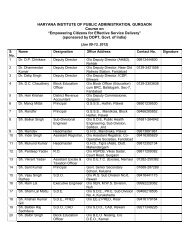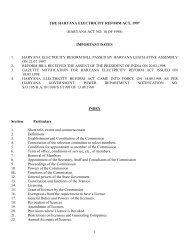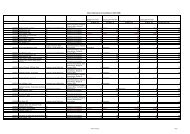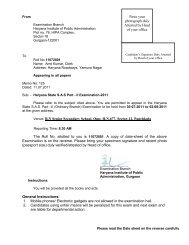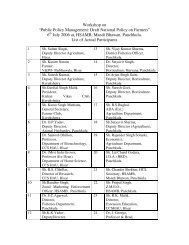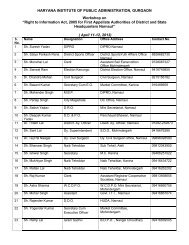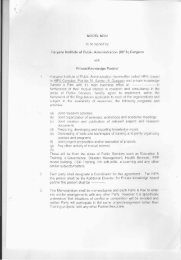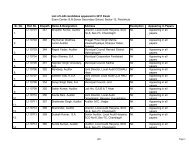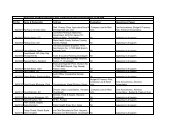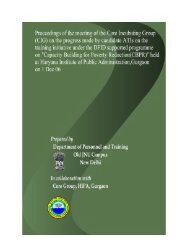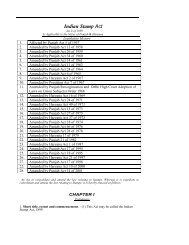1.Project Report- Phase I - HIPA
1.Project Report- Phase I - HIPA
1.Project Report- Phase I - HIPA
- No tags were found...
Create successful ePaper yourself
Turn your PDF publications into a flip-book with our unique Google optimized e-Paper software.
Project <strong>Report</strong> - <strong>Phase</strong> IMoving AheadAugust 2007
Project <strong>Report</strong> - <strong>Phase</strong> IMoving AheadAugust 2007
Chapter 1Chapter 2Chapter 3Chapter 4Chapter 5ContentsThe CBPR ProgramThe Training Initiative Setting the Agenda-The Shimla WorkshopThe Training Initiative Setting the Terms ofEngagement for the first phase Pilots- TheGurgaon August Workshop-IThe Training Initiative Preparation of theWorking Model- The Bhopal WorkshopThe Training Initiative Lessons Learnt48131622List of Abbreviations3Schematic Summary of CBPR Project6Selected Districts, Sectors in <strong>Phase</strong> I14Basic Elements of CBPR Working Model17Annexure I: Administrative Training Instituteundertaking Pilots under the Capacity Building forPoverty Reduction(Training Initiative)Annexure II: Core Project Management Team28302
List of AbbreviationsANMASIATICBPRCDPOCIGDAR&PGDfIDDLMDoPTDTS<strong>HIPA</strong>KSAMoPMoUPHCPRIRCVPNAARTITA/DATNAToTTQMUNDPYASHADAAuxiliary Nurse MidwifeAdam Smith InternationalAdministrative Training InstituteCapacity Building for Poverty ReductionChild Development Project OfficerCore Incubating GroupDepartment of Administrative Reforms and PublicGrievancesDepartment for International DevelopmentDistance Learning Mode (Material)Department of Personnel and TrainingDirect Trainers SkillHaryana Institute of Public Administration, GurgaonKnowledge, Skills and AttitudeMinistry of Personnel, Public Grievances and PensionsMemorandum of UnderstandingPrimary Health CentrePanchayati Raj InstitutionsRCVP Noronha Academy of Administration, BhopalRight to InformationTravelling Allowance/ Daily AllowanceTraining Needs Assessment (Analysis)Training of TrainersTotal Quality ManagementUnited Nations Development ProgrammeYashvantrao Chavan Academy of DevelopmentAdministration3
Chapter 1The CBPR Program1. BackgroundThe Ministry of Personnel, Public Grievance and Pensions (MoP) in its efforts to promoteand support improvements in publicadministration affecting the poor launched theCapacity Building for Poverty ReductionProgramme (CBPR) in February 2005. Theprogram is designed to supplement theevolving governance and fiscal reformsagenda and the State level initiatives topromote and achieve reforms at the cuttingedge or point of delivery. The program issupported through assistance fromDepartment for International Development(DfID) and will be implemented over fouryears (2005-06 to 2008-09). The Programreceived approval in February 2005 and waslaunched in June 2005.2. Programme ObjectiveSupport the MoP in its efforts to promote andsupport improvements in publicadministration (at all levels) for improving service delivery, leading to poverty reduction,through a programmatic approach.3. How does this Program impact povertyThe Government is no longer seenmerely as a law enforcer or acontroller of national resources. It isincreasingly viewed as a provider -albeit an efficient provider - of basicservices and public goods. Peopleexpect the Government to facilitategrowth and development. In thiscontext, civil servants have to shiftfrom being controllers to facilitatorsand from being providers toenablers. They need to equipthemselves with the necessaryskills and capabilities to meet thesenew challenges. They need tomaster new technologies and newstyles of functioning.It is now increasingly being accepted both in theory and practice that poverty is not alinear phenomenon. While income deprivation is a real and tangible manifestation ofpoverty, strategies to improve livelihood options by themselves might not have thedesired impact. The strategies used to fight poverty include providing social safety netsfor the vulnerable, stimulating growth and thereby employment opportunities,empowerment of the poor to access what is lawfully due, improvement in security andsafety to avoid exploitation, provide better access to public services etc.4Honble Prime Minister in his speech on theCivil Service Day, 21 April 2007
The CBPR Program purports to build capacities at the institutional, organizationaland individual levels to make an impact on poverty reduction through improving publicservice delivery which is largely accessed by the poor e.g. health, education, nutrition,sanitation etc..The linkage between improved service delivery and poverty reduction isenunciated below:a. Failure of public services would require the poor to rely on private serviceproviders which in most instances are a more expensive and poor qualityalternatives. Reliance on private sector for basic services would reduce the realincome of poor households and thus making them worse off.b. Good quality public services e.g. health, sanitation etc. ensures less lost earningsfor a poor household due to debilitating sickness. The opportunity cost of ill healthfor a poor household can be extremely high.c. Market responds only to those who have purchasing power, provisioning of publicservices ensures that the market failures is prevented and that basic services areavailable to the economically disadvantagedd. Improving access of the poor to the public services like health and educationincreases their earning potential thereby increasing their entitlements (i.e.,command over goods and services) which would help them to come out of the povertycycle.Improvement in public service deliverycan be brought about through increasingcapacities at:Institutional level: This includes impactingsocial and legal norms and rules that underlieprovisioning and distribution of goods &services. Enactment and enforcement of theRTI Act which provides information and voiceto citizens is an example for buildinginstitutional capacity and can be used byThe definition of capacity forpurposes of this program is theability of individuals, organizations,and the institutions (at the central,state and local level) to provideservices for the poor. The process ofstrengthening and sustaining suchcapacity is capacity building.citizens to demand better public services.Organizational Level: Encompasses strengthening the systems and processes of servicedelivery entities. For example, computerization of land records or establishment ofcommon service centers is an action towards increasing organizational capacity.Individual level: Incentivises and reinforces desirable behaviour amongst civil servant orprofessional in the service delivery hierarchy. For example: the present training initiative5
under the CBPR program which intends to develop a model for training service deliverypersonnel at the cutting edge is an example of such individual capacity building.The discussion above is summarized in the schematic below:Input Mediating Variable OutputCapacity Buildingfor Improvementin PublicAdministrationBetter ServiceDeliveryInstitutionallevelOrganizationallevelIndividuallevelPositive Impacton PovertyOther initiatives under theProgram organizationalstrengthening, user feedback,other user or citizen drivenpressuresDeveloping model for training offrontline Service DeliveryPersonnel (training initiative underthe CBPR Program)4 Positioning of the training initiative under the ProgramCivil servants or professionals, depending on the nature of service, render front lineservices. The effective and poor-friendly service delivery at various levels of governmentacross the country is significantly a function of the quality of the people across the servicedelivery chain. This is primarily dependent on the knowledge, skills, and attitudes (KSA)of the personnel at the front-line. Although organisational strengthening, user feedback,and other user or citizen driven pressures would have an effect on the performance of theservice delivery organisations, the final impact would be as good as the competence and6
orientation of the personnel at the delivery point. This is the person who the citizen asuser would be interacting regularly or whenever there is a need. The knowledge and skilllevels, orientation, and motivation of this person are of critical importance in the servicedelivery chain. While incentives are usually used for keeping the motivation levels high,orientation and knowledge levels are managed through appropriate traininginterventions. The CBPR programme has identified training and related interventions asone of the key input to capacity building efforts that need to be undertaken for achievingthe desirable outcomes of the programme.5. Training initiative in context of the national training policyThe National Training Policy in its vision of“training for all” acknowledges that theincidence of training is significantly low at thefront-line levels of the civil service. It furtheradds that concerted efforts have to be made toequip these functionaries to be moreresponsive to citizens and the poor inTraining would be imparted to allrungs of the Civil Services startingfrom the lowest and cutting-edge tothe highest in policy making.National Training Policyparticular. Many constraints have been identified in implementing the training policy.Absence of training policy for lower level civil servants, training infrastructure, trainers,and training material are some of the important constraints identified for attaining the“training for all objective”.Given the aforesaid constraints in operationalising the training policy for servicedelivery personnel at the cutting edge who comprise the lower end of the civil service,training had to be designed so as to be scalable, cost effective and transferable. Thetraining initiative under discussion proposes to develop a model for training servicedelivery personnel with all the aforesaid attributes.7
Chapter 2The Training InitiativeSetting the Agenda- The Shimla Workshop1. BackgroundndAt the Shimla workshop (22 -23June 06) on Training for servicedelivery one of the main suggestionswas about the development of areplicable model from theexperiences of the intensive districtlevel training implemented under theUNDP funded “Strengthening ofState ATIs” project. It also emergedthat the experiences of training offront-line service providers at thedistrict level at Satara by YASHADA(ATI Maharashtra) could form therdThe intensive district training modelimplemented under the UNDP program inseven districts including Satara provides abasic approach for training on a large scale.The question that is required to beanswered is whether the same model isreplicable both geographically andsectorally ? As it exists now the programcannot be replicable immediately sinceconcurrent process documentation of thesemodels is not available.Proceedings of the Shimla Workshopbasis for developing a model. The experiences of other ATIs which had implemented theUNDP project, namely, ATIs at Bhopal, Chennai and Kolkata would also inform thedevelopment of the model.The Satara experience included a training needs assessment effort, developmentof training material and pedagogy tools for training of front-line personnel in differentservice categories. The training was for all the critical attributes required in any jobnamely, knowledge, skills and attitudes. The impact assessment of this effort hasindicated positive results. However, the document of this effort has not been done inmanner conducive to replication, thereby making it difficult to assess the feasibility ofreplicating this experience. However a prima facie examination of the experiencessuggests that the approach and methodology of this effort has much to recommend it forbeing developed into a replicable model. The situation is similar insofar as the efforts inthe other ATIs who implemented the UNDP project are concerned.2 The ObjectiveIt was decided that the current effort under the CBPR programme is to develop a trainingmodel for the front line service delivery personnel, which is scalable, cost effective8
and transferable and thereby can be usedwith marginal changes across the country.However, this process has to be systematicand rigorous to ensure its transferability todifferent geographies and service sectors. Todevelop a replicable and transferable modelan initiative would be launched under theCBPR. This initiative would build on thelessons and experiences of the intensivedistrict training initiative of the UNDPproject. It was decided that the initiativeThe approach to training should beinformed by the scale and scope ofthe training requirements in thegovernment while keeping the costof delivery affordable. Thechallenge is to make the trainingsystem available, accessibleparticularly to the front-line staff ofthe service delivery units andaffordable for state government.Proceedings of the Shimla Workshopwould be rolled out in two stages:<strong>Phase</strong> I: Develop and test a replicable training model for the service delivery personnelat the cutting edge covering two identified sectors (per ATI) based on the IntensiveDistrict Training model implemented under the UNDP Project. The piloting of the <strong>Phase</strong> Iwould be done at four ATIs, namely, Bhopal, Chennai, Kolkata and Pune.<strong>Phase</strong> II: Establishing the replicability and robustness of the working modeldeveloped in the first phase. The pilot testing would be done at ten ATIs3. The steps decided for developing the modelThe main steps that were decided for undertaking the development of the model were(the steps given below are in a chronological order):1. Getting the inputs for developing the working model: A critical review of theexperiences of the training efforts undertaken at the different ATIs would need to bedone. The review would seek to highlight:a. the main objectives of the training,b. the target group,c. the process of identification of the trainees and their needs,d. the main pedagogical tools used and methodology for their development,e. the criteria used for choosing a specific pedagogical tools vis-à-vis thelearning objective,f. content of the training material and its relationship with the trainingobjective,g. choice of training infrastructure,h. duration of the training programme and session plans and,I. the process of training the trainers and choice of the trainers.9
This review should provide the basis for the four ATIs to develop a working model fortesting in new settings.2. Developing the Working Model: The working model would need to be finalizedbased on a joint discussion by all the four ATIs with inputs from the core group in aworkshop. This would help in developing a common understanding across the ATIsabout the nature of the model and it's testing in different states.3. Decide the geographical and sectoral context: Each ATI would decide on thegeography, sectors, and services from which trainees would be identified. The processwould need to cover the following aspects:a. Identification of the district which is most conducive in terms of availability ofresources and willingness of the district administration to spare personnel forthe required number of days for training purposes. Another criterion wouldbe the availability of suitable and adequate training infrastructure.b. Systematic identification of sectors that have the highest impact on the lives ofthe poor and have a high direct service delivery requirement through specifichuman interface.4. Identification of personnel for training: The identification of the appropriatepersonnel for training would need to be done based on Steps 1, 2, and 3 above. It isnecessary that appropriate sampling is done so as to ensure that the testing leads to betterresults. It was reiterated that it is not intended to train all the personnel in the selectedcadre, only a sample need to be trained which is sufficient enough to establish the workability of the model. Further, sufficient variety in jobs and training requirements wouldhave to be addressed for a meaningful test process.5. Preparation of a training schedule6. Implementing the training schedule: Implementing the schedule in the chosensectors and the chosen services.7. Development of an approach and methodology for training of trainers (ToT) at theATI and field level, which would include the necessary tools and techniques.8. Identify the costs associated with each component of the pilot and also arrive atthe per trainee cost given the different requirements. A model cost sheet with theestimates against each head will have to be prepared.9. Finalizing the Model: Based on the training related data and feedback from theparticipants the various components of the working model will have to be discussed anddetailed for finalizing the model.10. Testing the Replicability of the Model: The model developed in the first phase willbe tested for replicability in ten additional ATIs.10
4. Concurrent Documentation the overarching requirementOne of the most critical aspects of this wholeConcurrent documentation isexercise is concurrent documentation of everycritical. Post Facto reconstruction ofconcept, activity and process followed duringevents should be avoided sinceimplementation of the pilots beginning withmany critical aspects are lost and thatthe process of building the working model rationalization of events creeps in.through to the stage of finalising a replicable Documentation will not be used asmodel. The documentation will be the judgment of effort by an individualprimary data used for building the final ATI, but as raw data for constructingmodel.the model. It is very important thatall ATIs have the documentation5. Institutional Arrangementsperson in place from the beginningitself.a. Core Incubating Group (CIG) -This group would haverepresentation of resource person from select ATI(s) and chaired by Director(Training), DoPT. This group would be mandated to monitor the progress ofthe initiative and also abstract the model from the implementationexperience.b. ‘Think Tank’ to the Core Incubating Group- Haryana Institute of PublicAdministration, <strong>HIPA</strong> would act as the ‘Think Tank’ to the CIG. <strong>HIPA</strong> wouldalso act as a repository of the various training material developed and used bythe partner ATIs under the Intensive District Training Program or otherwise.c. Technical Backstopping: Adam Smith International (ASI), the ProgramManagement Consultants to the CBPR Program will provide technicalsupport as and when needed.6. Program Monitoringa. Monthly status report to be sent to DoPT/DAR&PGb. Utilisation certificate: Under the three generic heads to submit expenditure.The first utilization certificate is expected by Sept-Oct 07 for the moneyreleased in the financial year 2006-07 under the training initiative of the CBPRProgram. This will help release additional tranche of funds.c. The quarterly monitoring format to be sent to the CIG11
7. Output of the initiativeThe main outputs that would however be required to be produced at the final stage of thisinitiative are likely to be:1. The abstracted working model arrived at the beginning2. TNA process documentation3. The lessons from the testing process4. A replicable Training module giving:i. The main training objectivesii. The nature of training materials Readings Visuals Presentations Filmsiii. Pedagogy and the training(learning) objective matrixiv. Session design and sequencing plan.v. A list of pre-conditions for training at the district level.vi. Nature of preparedness of an ATI and methods to develop the trainersvii.at the ATI for this kind of initiative.A model cost-estimate for conducting such training modules forpersonnel at the front-line. This model would form the basis forestimating the cost for such training efforts.12
Chapter 3The Training InitiativeSetting the Terms of Engagement for the first phase pilots-The Gurgaon-I August Workshop1. BackgroundThe Gurgaon -1 (4 Aug 2006) workshop was aimed as a kick off for the <strong>Phase</strong> I of thetraining initiative. Intensive discussions were held with the four first phase ATIs, namely,Bhopal, Chennai, Kolkata and Pune. The terms of reference, MoU format, the budgetsand reporting & monitoring arrangements were discussed and finalized. The Shimlaworkshop guidelines were further detailed out and future course of action decided.2. Setting the Terms of Engagement for the participating ATIsA. Objective: Develop and test a nationally replicable training model for the servicedelivery personnel at the cutting edge covering two identified sectors (per ATI) based onthe Intensive District Training model implemented under the UNDP Program.b. Guiding principle: The training initiative is not a DoPT mandate thrust on theATIs, but rather a partnership. DOPT will endeavour to involve the ATIs and the states atevery stage of the program, and establishment of the Core Incubating Group (CIG) is oneway to institutionalize this participation. Decision was taken to establish an e-group ofthe participating ATIs to encourage interaction and experience sharing.c. Framework: A generic working model will be laid out before the ATIs start theimplementation process. All ATIs are expected to follow the generic working model.However within the prescribed framework the ATIs can innovate.d. Budget: The resources to be allocated to each ATI would be Rs. 40 lakhsPreparatory activities: Rs. 5 lakhsDesign of Training & related activities: Rs.15 lakhsIntensive Training: Rs. 15 lakhs Documentation: Rs. 5 lakhse. Geographic and sector context: Each ATI to choose two districts and pick up twosectors. No two ATIs will pick up common sectors. The selected sectors and districts by13
the four ATIs is given below:ATI District SectorAdministrative TrainingInstitute, KolkataNorth 24 ParganasAnimal ResourceDevelopment, HealthCare DeliveryRCVP Noronha Academy ofAdministration, BhopalBetul, Hoshangabad,RaisenSchool Education,Drinking Water Supply &SanitationYASHADA, Pune Pune Revenue & RuralDevelopment (PRIs-GramPanchayat)Anna Institute ofManagement, ChennaiVillupuram/Kanchipuram Poverty Alleviation/RuralHousing/VocationalTrainingf. Activities: The basis for the activities set out for the ATIs was the guidelines agreedupon in the Shimla Workshop. The broad indicative activities outlines were as follows:i) Setting up the objectives / selection of district and sectors / services /stakeholders analysis / TNA.Reviewing the existing trainingexperience/resources available from Intensive District Trainingprogramme.ii) Assessments of user satisfaction levels through assessment surveys /iii)finalize target group / cadres / identify training content, tools, etc., throughsurveys / discussion with participating ATIs through workshops etc.Designing training modules / material / audio visual inputs /printing ofmodules testing / finalization.iv) Training of Trainers / Intensive District Trainingv) Monitoring / evaluation / documentation and preparation of nationalreplicable model.3. Terms of Engagement for the Core Incubating GroupThe following is the Terms of Engagement for the Core Incubating Group, with14
secretariat at <strong>HIPA</strong>:i) Suggest the long term approach for building training capacity in the area ofii)iii)iv)public service deliveryIdentify / detail out the nature of interventions required to enhance thetraining capacity of the ATIsStudy the training and other initiatives pertaining to service delivery for thepoorDevelop an inventory of various training needs to the front-line servicedelivery personnelv) Develop training programmes with reference to the programmesvi)pertaining to the poorAct as a clearing house of ideas in the context of training in the CBPRProgramme15
Chapter 4The Training InitiativePreparation of the Working Model- The Bhopal Workshop1. BackgroundAs a follow-up of the guidelines decided atthe Shimla workshop, the workshopdeliberated and finalized the workingmodel to be followed in the first phasepilots.2. Inputs for the ModelThe experience of the four ATIs (Bhopal,Chennai, Kolkata and Pune) wasextensively discussed in the workshop andused for specifying the model.3. The ModelFigure below gives the working model on which the pilot would be based. The model issimilar to an equation wherein if we can properly specify the variables (independentvariables-left hand side box- “if we know”) then we should be able to predict thedependent variables (right hand side box- “we should be able to prescribe”). The model isbased on this input-output relationship.3.1 Input Variables (If we know side of the model)I. Training Needs Analysis would provide most of the values for the inputvariables. <strong>HIPA</strong> in collaboration with the partner ATIs will work on the methodology forthe Training Need Analysis for the national roll out. Also an a priori expectation exerciseof the stakeholders (e.g., service consumers) on the type of services experience theyprefer would be done through a methodology arrived at by <strong>HIPA</strong> in consultation with thepartner ATIs. The results would provide feedback into the training methodology design.II. Input Variable 1: TraineeThe trainee variable has several dimensions which need to be specified in the model.The dimensions include:16Building a model is essentiallyidentification of generic variablesthat can be abstracted fromexperience. The model can be furthersupplemented by providing a set ofandragogical tools, to facilitateimplementation. The model willhelp standardise the training forfront line service delivery personnel.The challenge is to get thereplicability elements right.Bhopal workshop proceedings
If we know…We should be ableto prescribe …The traineeWhich sector Nature of service Participatory (extension) Over the counter (OTC)service-delivery Individual/vertical Level (s) in theorganisation Nature of work of thetrainee(s) Technical aspects Citizen-interfaceObjective of trainingInformRe-orientEnhance capabilityScope of training( Workspace/Life space)What will the person be trainedin? Work SpaceKnowledgeSkillsAttitudeLife SpaceYogaHealth concernsPersonal financeScale of trainingGeographicalNumber of peopleTNA includingcitizenexpectationsTraining Evaluationand Impact Individual Organizational Service userEntry issuesInfrastructurePhysicalCentralisedLocalisedTraining materialCentralisedLocalisedAndragogicalDelivery modeDirectDistance TypeExperientialVicarious(Explict) Tools—developed locally(innovative) or adaptationof existing onesGamesRole playsLanguage ofcommunicationContentTechnicalBehaviouralTrainer/ Capacity BuilderSpecialistInternally developedTrainingenvironmentVenue—point offocusResidential vs.day scholarOther facilities CostsBy cost-headsCosting in terms of perperson cost17
a. Sector: Training intervention would depend on the sector from which thetrainee is chosen. The sectors were classified under three broad heads.i. Regulatory Sector: Revenue, PDS, Municipal Administration, Policeii. Development oriented sector: Agriculture, Rural Development, AnimalHusbandry, Rural employmentiii. Service Oriented sector: Water supply & Sanitation, Health, EducationEach of the broad sectors stated above would have different training interface.b. Nature of Service: Nature of service can either be participatory (e.g.agriculture extension, preventive health care) or over the counter (e.g.education, administration of pensions, etc.)c. Organisational scale: Whether the training is designed for all the personnelin the organisational hierarchy as a unit (e.g., ANM to the Medical officer ofthe PHC) or individual (only specified cadre- e.g., for Anganwadi workeronly and not the whole hierarchy stretching up to CDPO)d. Level in the organisation: Which hierarchy level does the trainee comefrom, on this would depend the training required (e.g. actual servicedelivery training vis-à-vis managing service delivery training).E. Nature of work: The training content will depend on the characteristics ofthe work content of the trainee ( For example, it can be technical aspects fora line man in the electricity utility vis-à-vis citizen interface skills would becritical for a Patwari/ Talati)III. Input Variable 2: Objective of trainingThe training design would depend on what skill sets are to be addressed. They maybroadly fall under the following heads, and can be exclusive or an amalgamation. Inform Re-orient Enhance capabilityIV. Input Variable 3: Scope of trainingTraining can concentrate on only job related areas (KSA) or may also include life issues(health, income tax calculations, yoga, fitness, etc.). Under intensive training, evidenceindicates that an amalgamation of work and life space training was successful.V. Input Variable 4: Scale of trainingThis includes the geographical location of training. Under intensive training project,while Theni provided training centrally at district headquarter, in Satara the training was18
geographically disaggregated across various locations. It is possible that training may betaken in one district or in multiple districts at the same time. All this would dictate thelevel of logistical arrangements and coordination requirement.3.2 Dependent VariablesOnce the independent variables were specified, the group discussed the dependentvariables (“we should be able to prescribe” box). The following is the consensus reached:I. Dependent Variable 1: Infrastructure RequirementThe training can be held either at one Central location/venue or can be made localised andcloser to the workplace of the trainee. It was decided that while localised training is apreferred mode, centralised training might however need to be considered if no suitableinfrastructure is available for geographically disaggregated training. For centralisedtraining the provision of allowance might be required to facilitate travel of the traineesfrom their place of stay to the centralised training venue. Hence, entry issues of theparticipants may be allowed a closer look. For example, age-sex of the participants, jobprofile and travel time, etc. may precede infrastructure requirement.II.Dependent Variable 2: Andragogya. Training MaterialA variety of training material is already available with the partner ATIs. Some of theinnovative tools and techniques discussed included: Performance Aid- a manual to be carried back by the participant to helphim/her in his daily workStory Board developed by Yashada and other ATIsSkit by the participants adopted by West Bengal and other ATIsFilms developed by Yashada- maybe be dubbed in local language by otherpartner ATIs Interactive software based learning toolIt was decided that <strong>HIPA</strong> would act as a repository of the various training materialdeveloped and used by the partner ATIs under the Intensive District Training Program orotherwise. <strong>HIPA</strong> will have to build this repository in coordination with the partner ATIseither through electronic contact or physical visits. Partner ATIs can draw upon therepository for accessing tools developed by other ATIs for use during piloting. DuringPilot good training session would be video graphed as a part of the documentation and19
would form the part of the repository.b. Direct v/s Distance LearningIt was decided that both the modes will be used. DoPT developed DLM packages will berevisited. It was felt that translation in local languages pertinent for each particular ATI isrequired. The translated version of the DTS/TQM module of the DLM attempted by theRCVPN Academy of Administration, Bhopal was appreciated by the participants.c. Type: Experiential v/s VicariousLearning takes place through experiential and vicarious means. People learn throughdoing which is experiential and from others which is vicarious. The effectiveness oftraining is dependent on choosing the appropriate type by the trainer depending on thetraining need. For example, skills and attitudes related learning is usually facilitatedthrough experiential training techniques whereas knowledge related learning is donevicariously, received knowledge. Role plays are typically experiential learning tools andlecture sessions are vicarious learning ones. It is important for the participating ATIs torecord the type being used in different contexts in the course of testing the model. Thiswould help in developing the appropriate learning technique for each context oflearning.III. Dependent Variable 3: TrainerThe group was of the view that a mix of both specialist and locally developed trainerswould be required. A large scale roll out cannot be attempted without developing locallydeveloped trainers preferably from within the cadres to be trainedIV.Dependent Variable 4: Environment of Traininga. Residential v/s Non-Residential (Day scholar)While Yashada supported residential training, the other partner ATIs were howeverskeptical as to availability of infrastructure and the logistics involved in doing aresidential program in their respective pilot districts. A large scale roll out at the nationallevel would be extremely daunting if the program is in the residential mode. The financialresource commitment would also be substantially higher than that for a day scholarprogram. However, the group did agree that residential program does have strongarguments in its favour. It was decided that residential v/s non residential- will depend20
on the requirement of the program. Probably skill training might not require residentialtraining whereas attitudinal training might require a residential mode.V. Dependent Variable 5: CostsA budget for the training program has to be prepared by each partner ATI and theexpenses monitored. It is proposed that a schedule of rates be developed at the end of thepilot. It was suggested that the cost calculation sheet in the DoPT manual can be used.Outsourcing processes if done during pilot have to be specified including the costsincurred. Decisions of what to outsource and what to internalize have both cost andefficiency implications and should be spelled out clearly in the documentation.3.3 Outcome assessments:It is necessary to develop training evaluation and impact assessment tools as a part ofthe model. Training evaluation is taken up immediately after the end of the trainingsessions, training impact assessment is deferred in time. It can be taken up at differentpoints in time after the trainees get back to their place of work. Training evaluationtools are more pervasive and are used more often than impact assessment. For thepurposes of this model it is necessary that both these tools are developed and tested.The feedback from these tools can help in fine tuning the model and enhance itsefficacy.21
Chapter 5The Training InitiativeLessons LearntThe first phase of the training initiative has provided some critical lessons which thesecond phase ATIs may consider incorporating in their training design of the pilots.1. Leadership is the key for the project success: Commitment, support andguidance of the top management of the ATI is critical for the Pilots to be successfullyimplemented.2. Composition and quality of the personnel comprising the Core Group is critical:The success of the Pilots would depend largely on the composition of a dedicated CoreGroup both in terms of numbers and quality of personnel. The nodal officer (team leaderof the Core Group) should preferably be a senior faculty member who has a high degreeof commitment and is a team player. One Finance personnel should be a member of theCore team. A dedicated documentation person for doing concurrent documentation is amust. Core group in addition should have at least two more members designated perdistrict, for hands-on implementation of the Pilots. The Core Group should be allowed toco-opt additional members from within the ATI faculty or outside expertise for specifictasks, e.g., training design, monitoring, etc. It is also important that the nodal officer andthe members of the Core Group enjoy tenure through the pilot phase. In case of frequentchange in the Core Group personnel the momentum is lost.3. Core Group should be delegated powers: At the outset, right on thecommencement of the project, a one-time approval of broad expenditure elements to theCore team personnel should be given. The Nodal Officer should then be allowed tosanction and manage the expenses on the aforesaid heads on a day to day basis. Thisallows for efficiency since each individual expense sanction does not have to follow theusual process which is generally long drawn. This is important since the project has to beimplemented in a time bound fashion. The Core Group in that case can provide fullattention to the task at hands and not dissipate energy on procedures and formalities.4. Interface with District Administration critical: Operationalising of the grass root22
training needs full cooperation of the district administration especially that of the districtcollector. The core group will have to depend on the district administration for logisticssupport and release of personnel for training. The experience has been that generally thedistrict administration is enthusiastic about the training initiative. However there havebeen instances that State Line Departments whose personnel work at the grass roots (e.g.,health) have not been cooperative to the desired level. Before the pilots are undertakenboth the district administration and state department have to be taken on board. It is alsocritical that the district administration appoints a district officer to be the counterpart ofthe ATI core group team member responsible for implementation of the pilot. Thedesignated district official is the interface between the District Administration and theCore Group of the ATI. It has been observed that the rapport between the designateddistrict officer and the core group member(s) assigned the district becomes extremelyimportant for smooth implementation of the training program in the field.5. Appropriate administrative entity be taken as the unit for organizing training: Toavoid the resources to be spread out thin, an appropriate administrative entity be pickedup for imparting training. In most cases the administrative entity picked up has been theblock. Training is organized block by block; this also eases arrangements of logistic. It isalso critical not to have too many training programs running concurrently, this may leadto strain on resources of the ATI Core Group and the quality of training might suffer.6. Training needs assessment is the critical input for success of the pilots: Theline departments and the district administration should be involved in the TNA. TheTNA may assess both work space and life space (360 degree TNA tried at many ATIs isa case in point). The TNA process should also bring about a sense of ownership in thetraining initiative amongst the Line Managers.7. Appropriate mix of Knowledge, Skills and Attitude in the training design mustbe ascertained: The experience has been that training should primarily concentrate onthe attitudinal aspects for the grass root service delivery personnel. However the TNAshould form the basis for deciding the appropriate mix of KSA8. Training Objective and indicators should be decided in the design stage: Trainingobjective and indicators to measure the attainment of the same should be decided forchecking the efficacy of the training effort. However while it is acknowledged that23
training should lead to attainment of pre set performance standards of the organization,setting of performance standards is beyond the scope of this assignment.9. Monitoring of the training initiative: While DoPT and Core Incubating Group at<strong>HIPA</strong> has set an elaborate monitoring mechanism, the individual ATIs and their CoreTeams should have an in-house monitoring in place and should primarily concentrate oninputs and process indicators. Extensive documentation and analysis of the same shouldbe a part of the monitoring process.10. Developing a Process Sheet: Forstandardizing the training process, theCore Group at the ATI should considerdevelopment of a process sheet. Thewhole training process should be brokenup into sub-processes and the processparameters including time, techniques,cost, precautions, etc., should bedetailed. The richness of the processsheet would be a function of the numberof sub processes detailed and analyzed.11. Training of Trainers (ToT):Conducting of the actual training isbeyond the scope of the resourcesavailable with the ATI, therefore creationof a cadre of trainers for imparting thetraining becomes crucial. While most ofthe first phase ATIs have identified the potential trainers from within the cadre to betrained, an interesting deviation has been to draw the potential trainers from across thegovernment departments in the district and not confined to the cadre which is proposedto be trained under the program. While the former has the advantage of the potentialtrainers having the appreciation of the domain, the latter provides the ATI a larger poolfrom which potential trainers could be selected.ATI Bhopal under the first <strong>Phase</strong> Pilot hasdeveloped a ToT program evaluationtool wherein each potential trainerundergoing ToT is tracked as to his/herlearning outcomes. A baseline data foreach candidate trainer is generatedthrough a questionnaire which iscompared to a similar dataset developedfor each candidate trainer at the end of theprogram. A composite score is calculatedand each candidate trainer slotted in aclass interval category vis-à-vishis/her learning outcomes. The Coregroup members in charge of fieldoperations in the district are advisedto have a close monitoring of thetrained trainers who have scored lowin the learning outcome score.12. Developing Training Material- Reinventing of the Wheel to be avoided: While24
some of the training material will have to be specific to the State in which the pilot is beingdone, most of the training material isgeneric and can be borrowed frompartner ATIs. <strong>HIPA</strong>Gurgaon is therepository of all the training materialdeveloped in the first phase. The secondphase ATIs can borrow the same andcustomize it to their requirements. In thefirst phase ATIs have developed a varietyof innovative training tools including roleplay, short films, puppet shows, streetplays, audio songs, film clippings, etc.13. Development of PerformanceAids: It is realized from the first phaseexperience that performance aids shouldbe developed for the trainees as a reference material in work situation. The second phaseATIs may consider developing performance aids.14. On the Job training and Use of Distance learning mode not adequately tried out:It is suggested that some of the second phase ATIs may consider experimenting withthese modes. In case the aforesaid is successful; this will give insights in furtherstrengthening the training model.15. Including Personal Aspects in the Training curriculum appreciated: Most of thefirst phase ATIs included in the training curriculum, modules dealing with personalrequirements of the Trainees like health check-up, yoga, etc., and this found great favourwith the trainees.16. Training material should be in easy to understand language and comprehensibleby the trainees: In some instances the training materials prepared either was in languagewhich was difficult to comprehend by the trainees or explained concepts in a mannerwhich was amenable to simplification. It should be remembered that the client for thetraining are group C and D employees and the training material should be able tocommunicate with them.Story of a File- YASHADA PuneAn innovative film, wherein a filenarrates its trials and tribulations as it ispassed from one table to another. Theessence of red tape is very well depictedin the filmRole play (theatre) module CIG-<strong>HIPA</strong>In collaboration with National School ofDrama (with inputs from M. K. Raina,leading theatre personality), a roleplaying module has been developed byCIG-<strong>HIPA</strong>. The Theatre based methodof training has been field tested indifferent Sectors25
17. Expenditure reporting has to be disaggregated: One of the intent of the pilots is tospecify per unit costs in the model. However the expense reporting has not been mostlylump sum, whereby costing of individual elements of the training process has not beenpossible. DoPT and CIG-<strong>HIPA</strong> has specified a format for expenditure reporting whichwill have to be strictly followed by the candidate ATIs.18. Tendency to aim for high numbers of trainees covered has to be avoided: Thetraining initiative under the CBPR Program is only intended to develop a replicablemodel. The number of trainees taken should be an adequate sample and not the totalpopulation. The program has neither the resources nor the mandate to aim for training allthe members of the selected cadres in the district. Once the model and the attendant toolsare developed under the CBPR Program, a larger plan scheme is intended to be rolled outby DoPT wherein a larger number of districts and sectors will be covered and saturationaimed for.19. Selection of Sectors: Sectors (and the concomitant public service) which havebeen selected under the training initiative are those which are accessed by the poor andthe disadvantage. In addition majority of the sectors also find mention in the XI and XIISchedule of the Constitution of India.20. The working model sometimes gets bypassed: In the thick of field levelimplementation, the operational issues sometimes take precedence over conceptualissues. The nodal officer should constantly keep revisiting the working model and theattendant workshop notes, so that conceptual clarity is not lost. In case of doubts, nodalofficer can contact DoPT/CIG -<strong>HIPA</strong> for clarifications.21. Concurrent documentation needs strengthening: Documentation is the keyelement which has to be taken extremely seriously. Without documentation, the modelbuilding exercise cannot be attempted and therefore the whole purpose of the programwould fail. Documentation should start with extensive field notes, which then needs tobe consolidated under sub headings as per the working model and then the finer aspectsdistilled. While the ATIs will attempt the first two, CIG will attempt the third aspect.Documentation should attempt to answer the WHAT?, WHY?, HOW?, WHEN?,WHERE? And WHO? for each of the subheads of the working model. Thedocumentation should ultimately allow the CIG to develop a decision support system26
wherein if one specifies the left side variables of the working Model (Bhopal) the rightside variables in the model get automatically answered. Intent is not to attempt for lastmile precision, but a 90% probability of right prediction is a good enough bet.Documentation officer should be in place before the second phase ATIs initiate the pilots.22. Each ATI should maintain a guard file on the pilot project: As a tool for havinggood documentation, Nodal Officer of each of the candidate ATIs may maintain a 'GuardFile' which should contain all notices, reports, documents, and other correspondence /documents pertaining to the project for institutional memory.23. The working model is not a static entity: ATIs are encouraged to provide inputsfor further enriching the working model based on their experiences during the pilot. CIGwill consider the said suggestions and incorporate them if found suitable.27
Annexure IAdministrative Training Institute undertaking Pilots under the Capacity Buildingfor Poverty Reduction(Training Initiative)Sr.No.First <strong>Phase</strong> ATIsInstitute Districts Sectors alreadyallottedName ofNodalOficerContactDetails1RCVP Noronha Academyof Administration, BhopalBetul,Hoshangabad,RaisenSchool Education,Drinking Water Supply& SanitationDr KumudiniSharmaTelefax:0755-24642442Anna Institute ofManagement, ChennaiVillupuram/KanchipuramPoverty Alleviation/RuralHousing/VocationalTrainingShri N.PalaniappanOff: 044-24937170Fax: 044-249370623Administrative TrainingInstitute, KolkataNorth 24 ParganasAnimal ResourceDevelopment, HealthCare Delivery, AgricultureDr. ArabindaGhoshOff: 033-23375244Fax:033-233739604YASHADA, Pune Pune Revenue & RuralDevelopment (PRIs-Gram Panchayat)Second <strong>Phase</strong> ATIsDr. SunilDhapteOff: 020-25608000Fax: 020-2560821812345Sardar Patel Institute ofPublic Administration,AhmedabadHaryana Institute ofPublic Administration,GurgaonAssamAdministrative StaffCollege, GuwahatiMCR HRD Instituteof Andhra Pradesh,HyderabadHCM RajasthanInstitute of PublicAdministration, JaipurTo be confirmedMewat, SonipatTo be confirmedMedak, KadapaUdaipurPRI and MunicipalServicesSchool Education, Health,General RevenueAdministration, PowerDistributionTo be confirmedRural Development,HealthAgriculture,Horticulture, WatershedDevelopment, SoilConservationShri DineshPatelDr. ManveenKaurShri PKBuragohainShri KalluriNageshwarRaoShri AKOjhaOff: 079-26748722Fax: 079-26749048Off:0124-2340690/691Fax: 0124-2348452Off: 0361-2363325Fax:0361-2362361Off: 040-23548294Fax: 040-23548489Off: 0141-2706556Fax:0141-270542067J & K Institute ofManagement and RuralDevelopment, Jammu &SringarUP Academy ofAdministration andManagement,LucknowBudgam,UdhampurJaunpur,Lucknow,SultanpurSocial Welfare,Elementary Education/School EducationMicro Credit SchemeRevenue AdministrationDr. Jahan AraJabeenShri AnuragYadavOff: 0191-2472825Fax-0191-2472778Off:0522-2379739Fax:0522-238674728
Sr.No.Institute Districts Sectors alreadyallottedName ofNodalOficerContactDetails8Uttranchal Academy ofAdministration,NainitalNanital,BageshwarWater Supply andSanitationDisaster Pre-emption,Preparedness & ReliefOff: 05942-2239720 /2236141Fax: 05942-2376429Himachal PradeshInstitute of PublicAdministration, ShimlaBilaspur,HamirpurPolice, Food and CivilSupplyShri KKHandaOff: 0177-2647855Fax: 0177-264717210Institute ofManagement inGovernment,ThiruvananthapuramTrivandrumTo be confirmedDr R RamMohanOff:0471-2304229Fax:0471-230239129
Core Project Management TeamDoPT (Training), New DelhiAnnexure IISr.No.Name Designation Phone E-mail1Sh Ajay SawhneyJoint Secretary(Training)011-26106314ajay.sawhney@nic.in2Sh. Vineet PandeyDirector(Training)011-26107960vineet.pandey@nic.in3Sh.Jerome MinzUnderSecretary(Training)011-26168761minz@nic.inCore Incubating Group, Haryana Institute of Public Administration, GurgaonSr.No.1Name Designation Phone E-mailProf J. GeorgeConvener,CIG-<strong>HIPA</strong>0124-2343088jgfedp@vsnl.net2Prof. Suresh Misra Joint Convener,CIG-<strong>HIPA</strong>0124-2345780drsureshmishra@hotmail.comProgram Management Consultants (Adam Smith International)Sr.No.12Name Designation Phone E-mailD. Durga Prasad AssociateDirectorSudipto SenguptaProgramManager011-41502291011-41502291durga.prasad@adamsmithinternational.comsudipto.sengupta@adamsmithinternational.com30
Training Division,Department of Personnel andTraining, Block 4,Old JNU CampusNew Delhi 110 067Fax: 011-26107962Haryana Institute of PublicAdministration,<strong>HIPA</strong> Complex, 76, Sector-18,Gurgaon-122001



